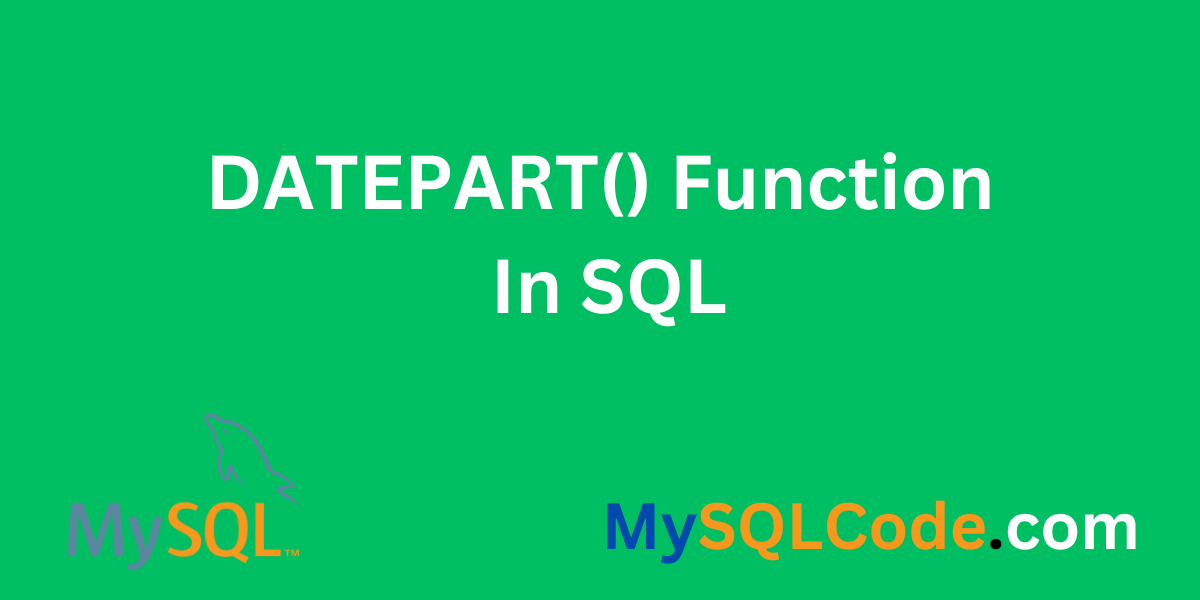In various models, we deal with the databases that contain information related to the time, date, year, month, and hour. This type of data is mainly present in the database of websites. We need to perform different operations on such type of data and DATEPART() is a function used to perform that operations. In this article, we will see every basic detail and example of the DATEPART() function. Let’s see the details.
Introduction to DATEPART() Function in SQL
In SQL Server, we use the DATEPART() function to pull out a specific part (like year or month) from date and time expressions. It’s very helpful when you need to get details about a certain part of the date or time value.
Syntax of DATEPART() Function
DATEPART(date_part, sample_date)The DATEPART() function is only for Microsoft SQL Server. If you use a different system for databases, doing the same thing might be possible with special functions made just for that system (like EXTRACT in PostgreSQL and MySQL). Remember that the DATEPART() parameter is not case-sensitive in SQL Server, but it might be different in other database systems. The given results will be numbers showing the part we got (like year, month or day).
Example of DATEPART() Function in SQL
In this example, we are using the AdventureWorks2019 database. The DATEPART() function extracts all the information like YEAR, MONTH, and DAY from the database. This is the simple syntax used to implement the DATEPART() function in SQL. You can replace your database to execute your model.
USE AdventureWorks2019;
SELECT
Order_ID,
Order_Date,
DATEPART(YEAR, Order_Date) AS Order_Year,
DATEPART(MONTH, Order_Date) AS Order_Month,
DATEPART(DAY, Order_Date) AS Order_Day
FROM
Sales.SalesOrderHeader;Code language: SQL (Structured Query Language) (sql)Advantages of DATEPART() Function in SQL
The DATEPART() function in SQL helps a lot when dealing with date and time data. It’s very useful! Here are some of the key advantages:
1. Date and Time Extraction
The main benefit of DATEPART() is its power to get certain parts from date and time values. This is very important when you need to examine or tell others about certain details of time and date information.
Also Read: MySQL date and time functions
2. Ease of Use
It makes it easier to get parts like the year, month, day and time (hour/minute/second) from dates or times. This makes it simpler to handle date info in a more detailed way.
3. Facilitates Grouping and Aggregation
The function helps to bundle and sum up data according to certain date or time parts. For example, you may want to combine sales information by month or study how events spread out throughout different times of the day.
4. Filtering Based on the Date
With its capabilities of efficient date-based filtering, it allows for greater precision in selecting the desired data. By utilizing the DATEPART() function within the WHERE clause, one can effectively filter rows based on specific date or time conditions. This feature proves to be particularly useful when one wishes to narrow down their search to orders placed in a particular month or year, providing a more tailored and focused result.
5. Analysis-Time Series
Allowing for trend analysis, DATEPART() is valuable in breaking down a time series into its constituent parts and conducting seasonality detection, as well as providing other time-related insights for time series analysis.
Limitations of DATEPART() Function in SQL
Certain limitations and considerations, while the DATEPART() function in SQL Server is a powerful tool for extracting specific components from date and time values.
1. Components Limited Date
The purpose of the DATEPART() function is to extract specific components of a date and time, such as the year, month, day, hour, minute, and second. However, it does not offer direct assistance for more intricate calculations involving dates or durations between dates.
2. Support Limited Time Zones
The DATEPART() function, unfortunately, does not possess the innate capability to carry out time zone conversions or take into account time zone considerations. If your application demands the management of different time zones, it is essential to incorporate supplementary functions or consider additional factors.
3. Functions Period Lack
Although the DATEPART() function grants you the ability to extract separate elements, it does not provide direct assistance in manipulating date intervals or periods. To perform calculations involving these periods, one might have to employ additional logic or utilize other functions.
Summary
In this article, we have seen the basics of DATEPART() function. The extraction of information related to time and date is easy due to this function in SQL. The various advantages and limitations of the DATEPART() function are also mentioned in detail. Hope you will enjoy this article.
